You know you need an alignment so whatever it is you drive won't handle like it's riding on a bowl of cottage cheese. Your hippy neighbor with the plug-in hybrid knows he needs one so he can squeeze another tenth of a gallon from his part-time gas tank. Your mother knows she needs one so she can wring another 500 miles out of her wood-clad Plymouth's Costco tires.
Turns out, everybody's right. The way a suspension's bits line up with whatever chassis they're connected to can make a car handle better, improve gas mileage, and make tires last longer.
 | Every car has some sort of predetermined amount of camber, caster, and toe that the manufacturer recommends. Straying from those recommendations can lead to better performance or a whole lot of chaos and a trashed set of tires.
| Every car has some sort of predetermined amount of camber, caster, and toe that the manufacturer recommends. Straying from those recommendations can lead to better performance or a whole lot of chaos and a trashed set of tires.
WHAT'S IN AN ALIGNMENT?
Any car can be thrown out of alignment, but not every car can be readjusted the same way. Before you know how to set yours straight, though, you've got to understand the lingo.
 | Understanding Your Cars Alignment Wheel Toe
| Understanding Your Cars Alignment Wheel Toe
- Toe: We're talking about the direction a tire's pointing when viewed from above. You've got three scenarios here: toe-in, where a tire's turned inboard; toe-out, where it's doing the opposite; and neutral, where it's pointing straight ahead. Instinct tells you neutral's best since excessive toe can mangle up a set of tires, but your instincts would be wrong much of the time.
 | Understanding Your Cars Alignment Wheel Camber
| Understanding Your Cars Alignment Wheel Camber
- Camber: Stand in front of your car and pay attention to whether or not your wheels tip toward or away from their fenders. You're looking at camber, which, like toe, can be represented in three ways: negative, where the tire's tipped inward; positive, where it's doing the opposite; and neutral, where it's sitting straight.
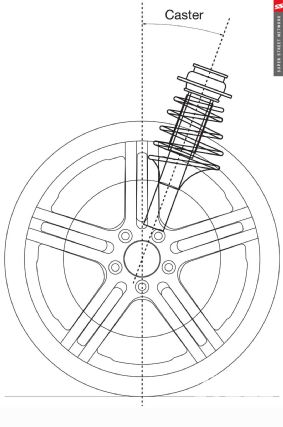 | Understanding Your Cars Alignment Caster
| Understanding Your Cars Alignment Caster
- Caster: A whole lot more mystical than toe or camber, caster represents the tilt of the upper ball joint or top of the strut relative to the lower ball joint when viewed from the side. Caster's as important as it is confusing; bungle it up and you've just made everything a whole lot less stable. Although it can be moved around, positive caster's standard on almost every modern car.
BUT WHY ALIGN?
There are really only two reasons you'll ever need an alignment: to correct disrupted settings caused by normal wear and tear or to introduce your own settings that care more about performance.
Mucked-up toe is why most cars end up on the alignment rack, though. Disrupt your car's intended toe with a quickness by plunking into a curb or by altering ride height. Your steering wheel clocked 20 degrees while driving in a straight line is a good indication toe's gone awry, however, an equal amount of bungled-up toe on each side will ravage a set of tires just as quickly and with fewer signals. Camber is just as susceptible. With some suspensions, it'll naturally err toward negative once a car's been lowered, which makes it another common culprit for any alignment. Leave either of these unaddressed long enough and you can kiss whatever tires you've got goodbye.
NOT ALL ALIGNMENTS ARE CREATED EQUAL
There's no single right way to align a car for every situation. What's good for the road course might not be best for the drag strip and probably won't do your tires any favors on the street.
 | In most cases, daily driven street cars need not veer too far from whatever alignment settings the manufacturer suggests. Doing so could lead to premature tire wear, damaged suspension bits, and poor handling.
| In most cases, daily driven street cars need not veer too far from whatever alignment settings the manufacturer suggests. Doing so could lead to premature tire wear, damaged suspension bits, and poor handling.
- STREET SETUP. You're probably not any smarter than whomever it is that designed your car, which means altering your alignment beyond what the manufacturer suggests rarely ends well. In most cases, lowering a car introduces negative camber and toe changes that can lead to premature tire wear. A small amount of negative camber all around can improve grip by better planting the tires' tread on the ground when under load, but anything more than a degree or two should be sorted out. For street cars, toe changes other than what the factory recommends is just asking for bald tires. Often times, settings other than neutral are recommended for the sake of straight-line stability and steering response at higher speeds
Pros: Retain the same sort of stability, handling, and tire life the manufacturer intended.
Cons: Don't expect the same sort of handling you would from a track car.
 | Drag cars require unique alignment settings that account for the weight that's typically unloaded from the front tires when launching and accelerating.
| Drag cars require unique alignment settings that account for the weight that's typically unloaded from the front tires when launching and accelerating.
- DRAG SETUP. Watch a proper drag car rise when launching and all of a sudden you'll understand that aligning it just got a whole lot more complicated. Here, adjust front camber and toe for the sort of things that'll only happen once the leading half of the car unloads from its suspension. Depending on the chassis, camber may err toward positive and toe may orient inward when all of this occurs. Counter it by doing the opposite without introducing too much of either. In most cases, rear settings ought to remain neutral to reduce drag.
Pros: Do it right and you've just increased grip and reduced rolling resistance.
Cons: On the street, these sort of settings can lead to less stability and a whole lot more tire wear.
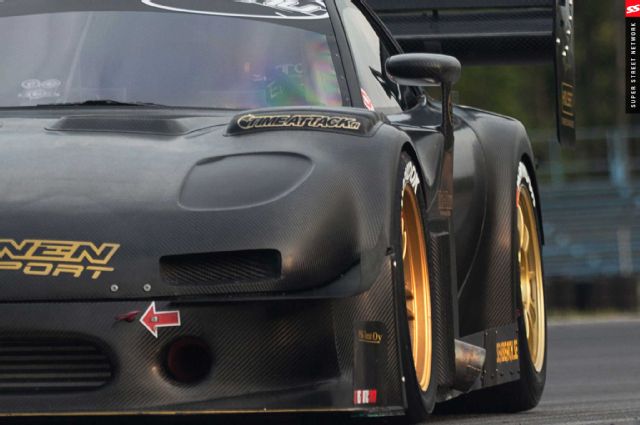 | Understanding Your Cars Alignment Track Car
| Understanding Your Cars Alignment Track Car
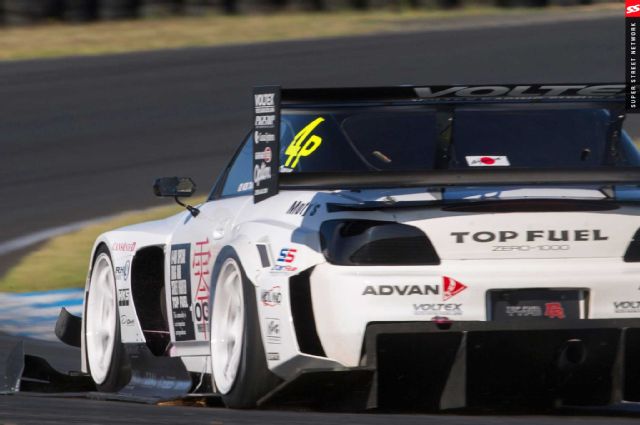 | A proper track car will exhibit just the right amount of negative camber-no more no less. To achieve all of this, each tire's temperature is monitored in several key spots, which helps determine what sort of changes ought to be made.
| A proper track car will exhibit just the right amount of negative camber-no more no less. To achieve all of this, each tire's temperature is monitored in several key spots, which helps determine what sort of changes ought to be made.
- CIRCUIT SETUP. At last, negative camber at both ends is your friend. Depending on a whole lot of factors, including tire compound, as much as three or four degrees might be needed. A tire pyrometer can be used in between laps to document the tires' inner, middle, and outer tread block temperatures. Here, camber can be fine tuned until temperatures in all three spots and at all four corners are about the same. Like camber, toe is also dependent upon all sorts of other factors, however, in most cases, a small amount of inward toe up front (about 1/16-inch) on understeer-prone front-wheel-drive and all-wheel-drive vehicles makes for a good starting point. For rear-wheel-drive cars that tend to oversteer, consider a similar toe adjustment at the business end but in the opposite direction for increased rear-end stability.
Pros: Set your suspension up like this and you'll utilize as much of your tires as possible, achieve better steering response, and help lead to the sort of understeer or oversteer correction you've always dreamed about.
Cons: Get it wrong and alter camber too much and the exact opposite can happen. Or, do all of this on a street car and watch the inner edges of your tires wither away.
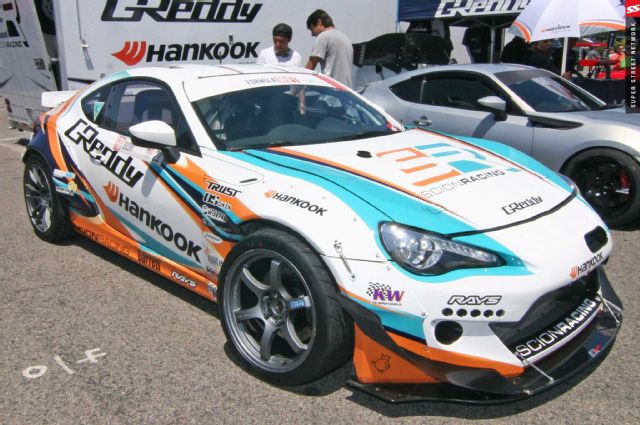 | Understanding Your Cars Alignment Drift Car
| Understanding Your Cars Alignment Drift Car
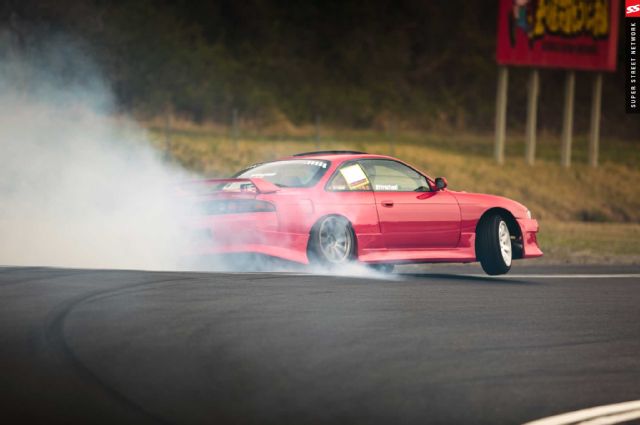 | Drift cars and road racing cars, for example, share many of the same alignment settings. Drift cars, however, benefit from a significant amount of positive caster, which can ease steering inputs.
| Drift cars and road racing cars, for example, share many of the same alignment settings. Drift cars, however, benefit from a significant amount of positive caster, which can ease steering inputs.
- DRIFT SETUP. Setting up your car for drifting isn't a whole lot different than setting it up for the road course. Here, negative camber and a bit of positive toe up front rules and helps keep the tires' tread on the ground, where it belongs, as well as reduces understeer and promotes sharper turn-ins. You've also got to consider caster, realizing that more is better and helps take the effort out of steering and retains negative camber once the wheels are turned.
Pros: Do all of this right and you've just made it easier to turn, slide, and retain traction when you need it.
Cons: As you'd expect, this sort of negative camber on anything other than a drift car is just asking for a tire swap.
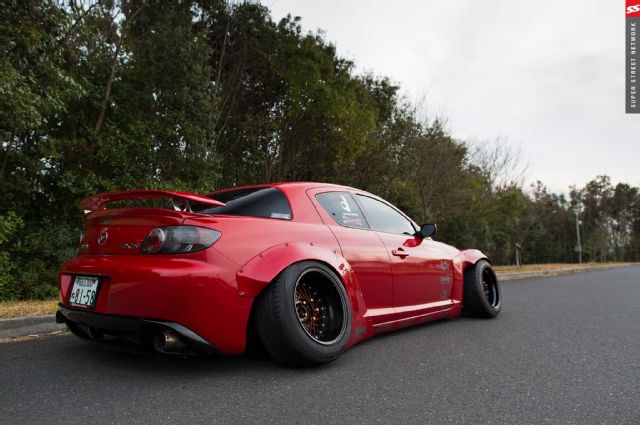 | A lot of times, a show car's alignment settings are put into place for no other reason than aesthetics. It isn't always a bad thing, but can often be detrimental to the tires if driven that way. The most extreme case: Koichiro Hayashi's RX-8 uses excessive amounts of negative camber to get his wheels as wide as possible, and getting his car as low as possible. Don't try this at home kids!
| A lot of times, a show car's alignment settings are put into place for no other reason than aesthetics. It isn't always a bad thing, but can often be detrimental to the tires if driven that way. The most extreme case: Koichiro Hayashi's RX-8 uses excessive amounts of negative camber to get his wheels as wide as possible, and getting his car as low as possible. Don't try this at home kids!
- SHOW SETUP. Preparing your car's suspension for any sort of event that doesn't require your engine to be running is the only one of the bunch that's as subjective as it is counterintuitive. Here, reducing ride height by whatever means necessary typically rules and is often accomplished by means of a hot mess of negative camber.
Pros: Introduce enough negative camber and you've just allowed for a little more space between the tires and their fenders. That and, it'll make the stance kids happy.
Cons: Hit the road like this at your tires' own peril and with a contact patch that'll throw a suspension engineer into a fit. Aside from shoddy tires, few things degrade handling more than excessive camber.
HOW TO DO IT
In most cases, you'll need to tap into the aftermarket to make any significant alignment changes. For A-arm suspensions, look to companies like SPC Performance for their adjustable upper ball joints or TruHart for their replacement control arms with integrated sliding ball joints. Both allow for easy camber changes up front without doing so much as removing the wheels and twisting a few screws. For MacPherson strut suspensions, the answer is as simple as a set of eccentric bolts that slide the strut side to side when twisted or as elaborate as a fancy set of billet-aluminum camber plates that allow for easy adjustability from within the engine bay. Toe changes can be made just as easily, typically with some sort of adjustable links or arms that either pull or push the leading or trailing edges of a tire from the chassis.
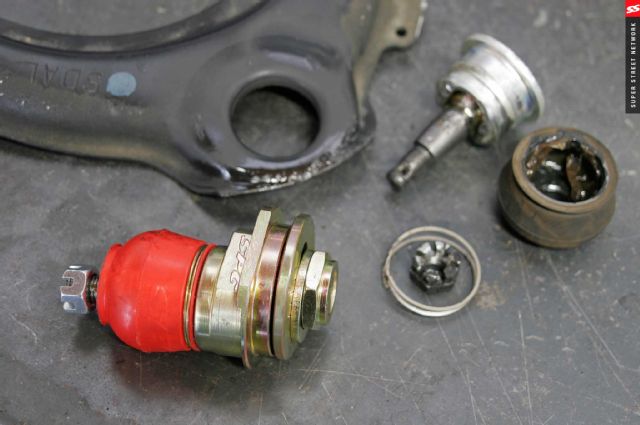 | Adjustable ball joints like these from SPC Performance allow for easy camber adjustments by simply removing the wheel and turning the locknut.
| Adjustable ball joints like these from SPC Performance allow for easy camber adjustments by simply removing the wheel and turning the locknut.
WHEELS, TIRES, AND OFFSET
You want wider wheels with deeper lips but whoever made your car didn't give you enough room for any of that. Which is exactly why you ought to know everything you can about camber and offset. Offset is simply a measurement of where the wheel's hub-mounting surface is located in relation to the rest of the wheel. Move it toward the chassis (negative offset), and you've just pushed the bulk of your wheel away from its fender. Do all of this right and with more negative camber than what any suspension engineer worth his degree will condone and you've just allowed enough room for those nine-inch wide rims on your Civic. When calculating offset, don't forget to compensate for whatever tires you might be using. Worried about them hitting something like a strut? Decrease offset further (a numerically larger negative number) to move everything away even more. Beware of dramatic offset changes, though; disrupt all of this enough and you'll increase understeer and change how the car reacts when steering.
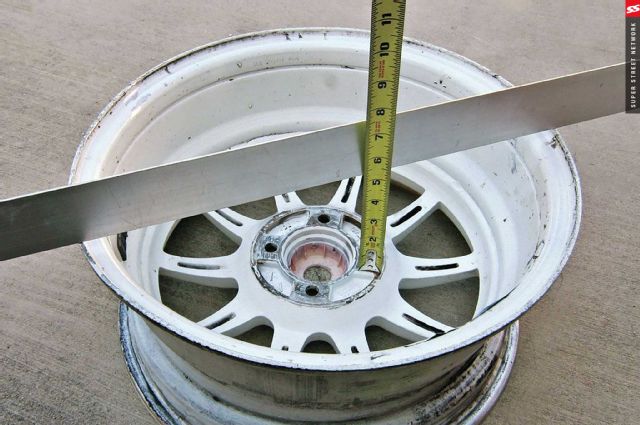 | Measuring offset is easy and you only need a straight-edge and tape measure to do it. Start by measuring the wheel's backspacing, which is the distance between its hub-mounting surface and the edge of its backside. To determine offset, subtract the wheel's centerline (half its width) from this figure. Voila!
| Measuring offset is easy and you only need a straight-edge and tape measure to do it. Start by measuring the wheel's backspacing, which is the distance between its hub-mounting surface and the edge of its backside. To determine offset, subtract the wheel's centerline (half its width) from this figure. Voila!
ALIGNMENT QUESTIONS, PRO ANSWERS
SS: Why is a proper alignment crucial?
Mark Willis, SPC Performance: An alignment does three things: keeps a car driving straight, keeps the steering wheel straight, and allows the tires to wear properly. If any of those three go bad, you need an alignment. My personal recommendation is to get an alignment every year as preventative maintenance. Suspension wear, sagging springs, and the cost of replacement tires can all make an alignment less expensive than the alternative.
Jerry McGovern, TruHart Technical Supervisor: When a car leaves the factory, it's set to predetermined specifications to keep it driving straight, maximize handling and safety, and minimize tire wear. Once these specs are altered due to suspension modifications, the car will not perform as designed and will jeopardize safety. On the other hand, you can alter the OEM specs to gain handling performance. This is where our products come into play, which lets consumers adjust suspension components beyond what the factory parts allow.
SS: How drastic can settings differ between a daily driver and a track car?
MW: There can be quite a difference. Consider the commuter who spends hours traveling the interstate; that car would be set up for directional stability and ride quality as opposed to an autocross racer who requires a setup for quick cornering and fast reactions.
JM: Depending on the situation, dedicated track cars will use larger amounts of camber and toe to get the car to turn into corners more quickly and have more grip whilst cornering. On your everyday car, toe settings are neutral and camber is only a few degrees negative. Although, with the recent growth of the stance scene, TruHart has adapted and created camber kits that will allow a lot of negative camber so more aggressive wheels can fit.

